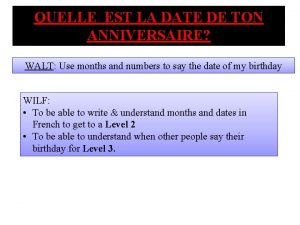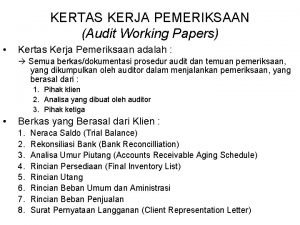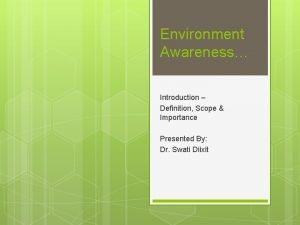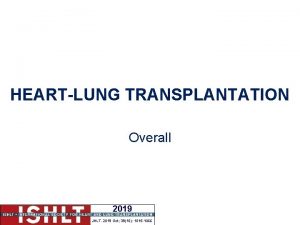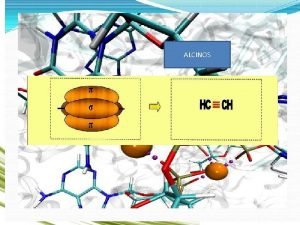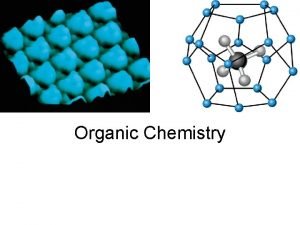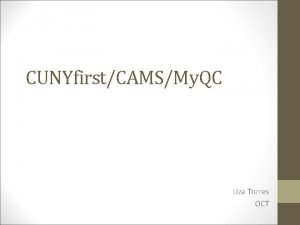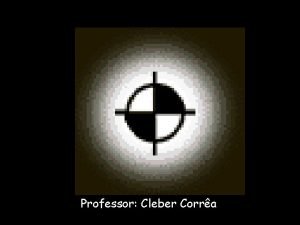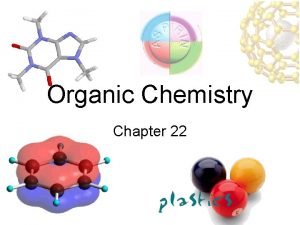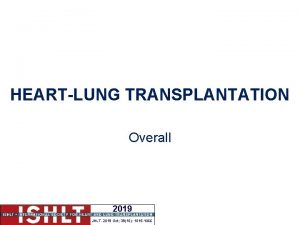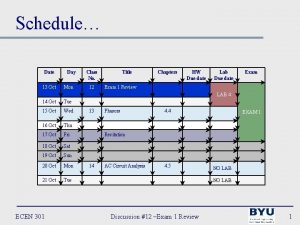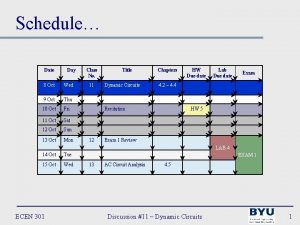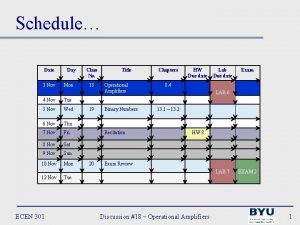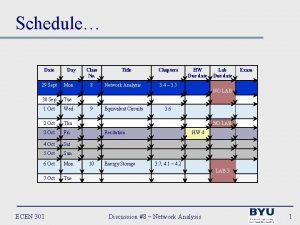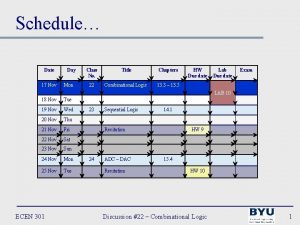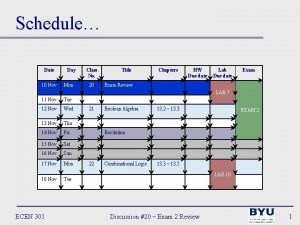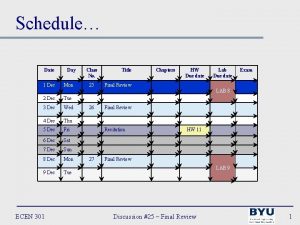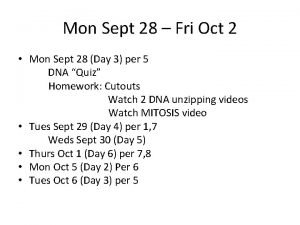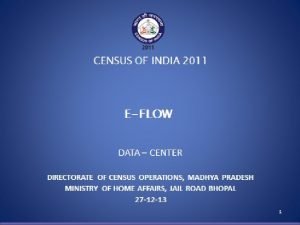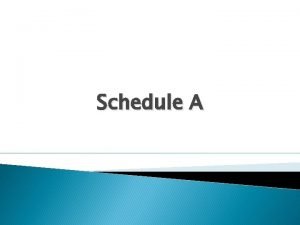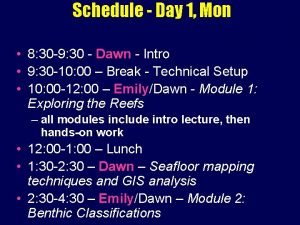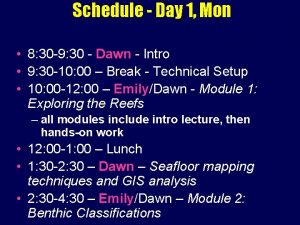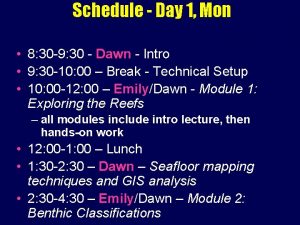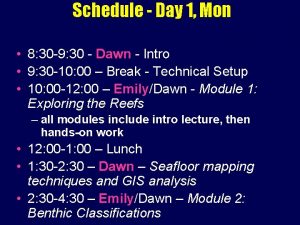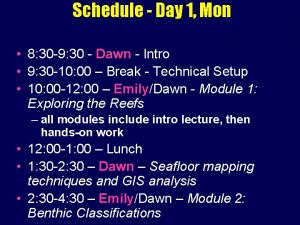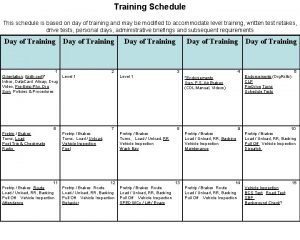Schedule Date Day 20 Oct Mon 21 Oct









































- Slides: 41

Schedule… Date Day 20 Oct Mon 21 Oct Tue 22 Oct Wed 23 Oct Thu 24 Oct Fri 25 Oct Sat 26 Oct Sun 27 Oct Mon 28 Oct ECEN 301 Class No. Title Chapters 14 AC Circuit Analysis 4. 5 HW Due date Lab Due date Exam NO LAB 15 Transient Response 1 st Order Circuits 5. 4 Recitation 16 Transient Response 2 nd Order Circuits HW 6 5. 5 Tue LAB 5 Exam 1 Discussion #14 – AC Circuit Analysis 1

Obedience = Happiness Mosiah 2: 41 41 And moreover, I would desire that ye should consider on the blessed and happy state of those that keep the commandments of God. For behold, they are blessed in all things, both temporal and spiritual; and if they hold out faithful to the end they are received into heaven, that thereby they may dwell with God in a state of never-ending happiness. O remember, remember that these things are true; for the Lord God hath spoken it. ECEN 301 Discussion #14 – AC Circuit Analysis 2

Lecture 14 – AC Circuit Analysis Phasors allow the use of familiar network analysis ECEN 301 Discussion #14 – AC Circuit Analysis 3

RLC Circuits Linear passive circuit elements: resistors (R), inductors (L), and capacitors (C) (a. k. a. RLC circuits) ÙAssume RLC circuit sources are sinusoidal R 1 vs(t) + ~ – ia(t) ix C Time domain ECEN 301 ZL ZR 1 L ib(t) R 2 Ix + – Vs(jω) Ia(jω) ZC Ib(jω) ZR 2 Frequency (phasor) domain Discussion #14 – AC Circuit Analysis 4

RLC Circuits - Series Impedances u Series Rule: two or more circuit elements are said to be in series if the current from one element exclusively flows into the next element. Ù Impedances in series add the same way resistors in series add Z 1 Z 2 Zn Z 3 ∙∙∙ ZN ∙∙∙ ZEQ ECEN 301 Discussion #14 – AC Circuit Analysis 5

RLC Circuits - Parallel Impedances u Parallel Rule: two or more circuit elements are said to be in parallel if the elements share the same terminals Ù Impedances in parallel add the same way resistors in parallel add Z 1 ECEN 301 Z 2 Z 3 Zn ZN Discussion #14 – AC Circuit Analysis ZEQ 6

RLC Circuits AC Circuit Analysis 1. Identify the AC sources and note the excitation frequency (ω) 2. Convert all sources to the phasor domain 3. Represent each circuit element by its impedance 4. Solve the resulting phasor circuit using network analysis methods 5. Convert from the phasor domain back to the time domain ECEN 301 Discussion #14 – AC Circuit Analysis 7

RLC Circuits u Example 1: find is(t) Ù vs(t) = 10 cos(ωt), ω = 377 rad/s R 1 = 50Ω, R 2 = 200Ω, C = 100 u. F R 1 is(t) vs(t) + ~ – ECEN 301 R 2 C Discussion #14 – AC Circuit Analysis 8

RLC Circuits u Example 1: find is(t) Ù vs(t) = 10 cos(ωt), ω = 377 rad/s R 1 = 50Ω, R 2 = 200Ω, C = 100 u. F 1. R 1 is(t) vs(t) + ~ – ECEN 301 Note frequencies of AC sources Only one AC source - ω = 377 rad/s R 2 C Discussion #14 – AC Circuit Analysis 9

RLC Circuits u Example 1: find is(t) Ù vs(t) = 10 cos(ωt), ω = 377 rad/s R 1 = 50Ω, R 2 = 200Ω, C = 100 u. F 1. 2. Note frequencies of AC sources Convert to phasor domain Z 1 = R 1 is(t) vs(t) + ~ – ECEN 301 Vs=10 ej 0 R 2 C Is(jω) + ~ – Discussion #14 – AC Circuit Analysis Z 2=R 2 Z 3=1/jωC 10

RLC Circuits u Example 1: find is(t) Ù vs(t) = 10 cos(ωt), ω = 377 rad/s R 1 = 50Ω, R 2 = 200Ω, C = 100 u. F 1. 2. 3. Z 1 = R 1 Vs=10 ej 0 + ~ – ECEN 301 Note frequencies of AC sources Convert to phasor domain Represent each element by its impedance Is(jω) Z 2=R 2 Z 3=1/jωC Discussion #14 – AC Circuit Analysis 11

RLC Circuits u Example 1: find is(t) Ù vs(t) = 10 cos(ωt), ω = 377 rad/s R 1 = 50Ω, R 2 = 200Ω, C = 100 u. F Z 1 = R 1 Vs=10 ej 0 + ~ – ECEN 301 Node a Is(jω) Z 2=R 2 1. 2. 3. 4. Note frequencies of AC sources Convert to phasor domain Represent each element by its impedance Solve using network analysis • Use node voltage and Ohm’s law Z 3=1/jωC Discussion #14 – AC Circuit Analysis 12

RLC Circuits u Example 1: find is(t) Ù vs(t) = 10 cos(ωt), ω = 377 rad/s R 1 = 50Ω, R 2 = 200Ω, C = 100 u. F 4. Z 1 = R 1 Vs=10 ej 0 + ~ – ECEN 301 Node a Solve using network analysis • Use node voltage and Ohm’s law Is(jω) Z 2=R 2 Z 3=1/jωC Discussion #14 – AC Circuit Analysis 13

RLC Circuits u Example 1: find is(t) Ù vs(t) = 10 cos(ωt), ω = 377 rad/s R 1 = 50Ω, R 2 = 200Ω, C = 100 u. F 4. Z 1 = R 1 Vs=10 ej 0 + ~ – ECEN 301 Node a Solve using network analysis • Use node voltage and Ohm’s law Is(jω) Z 2=R 2 Z 3=1/jωC Discussion #14 – AC Circuit Analysis 14

RLC Circuits u Example 1: find is(t) Ù vs(t) = 10 cos(ωt), ω = 377 rad/s R 1 = 50Ω, R 2 = 200Ω, C = 100 u. F 4. Z 1 = R 1 Vs=10 ej 0 + ~ – ECEN 301 Node a Solve using network analysis • Use node voltage and Ohm’s law Is(jω) Z 2=R 2 Z 3=1/jωC Discussion #14 – AC Circuit Analysis 15

RLC Circuits u Example 1: find is(t) Ù vs(t) = 10 cos(ωt), ω = 377 rad/s R 1 = 50Ω, R 2 = 200Ω, C = 100 u. F 4. Z 1 = R 1 Vs=10 ej 0 + ~ – ECEN 301 Node a 5. Solve using network analysis • Use node voltage and Ohm’s law Convert to time domain Is(jω) Z 2=R 2 Z 3=1/jωC Discussion #14 – AC Circuit Analysis 16

RLC Circuits u Example 2: find i 1 and i 2 Ùvs(t) = 155 cos(ωt)V, ω = 377 rads/s, Rs = 0. 5Ω, R 1 = 2Ω, R 2 = 0. 2Ω, L 1 = 0. 1 H, L 2 = 20 m. H Rs is(t) vs(t) + ~ – ECEN 301 R 1 i 1(t) L 1 R 2 i 2(t) L 2 Discussion #14 – AC Circuit Analysis 17

RLC Circuits u Example 2: find i 1 and i 2 Ùvs(t) = 155 cos(ωt)V, ω = 377 rads/s, Rs = 0. 5Ω, R 1 = 2Ω, R 2 = 0. 2Ω, L 1 = 0. 1 H, L 2 = 20 m. H Rs 1. is(t) vs(t) + ~ – ECEN 301 R 1 i 1(t) L 1 R 2 Note frequencies of AC sources Only one AC source - ω = 377 rad/s i 2(t) L 2 Discussion #14 – AC Circuit Analysis 18

RLC Circuits u Example 2: find i 1 and i 2 Ùvs(t) = 155 cos(ωt)V, ω = 377 rads/s, Rs = 0. 5Ω, R 1 = 2Ω, R 2 = 0. 2Ω, L 1 = 0. 1 H, L 2 = 20 m. H 1. 2. Rs is(t) vs(t) + ~ – R 1 i 1(t) L 1 Note frequencies of AC sources Convert to phasor domain R 2 Zs = Rs L 2 Vs=155 ej 0 + ~ – Is(jω) i 2(t) I 1(jω) ZR 1=R 1 I 2(jω) ZL 1=jωL 1 ECEN 301 Discussion #14 – AC Circuit Analysis ZR 2=R 2 ZL 2=jωL 2 19

RLC Circuits u Example 2: find i 1 and i 2 Ùvs(t) = 155 cos(ωt)V, ω = 377 rads/s, Rs = 0. 5Ω, R 1 = 2Ω, R 2 = 0. 2Ω, L 1 = 0. 1 H, L 2 = 20 m. H Zs = Rs Vs=155 ej 0 + ~ – Is(jω) I 1(jω) ZR 1=R 1 Note frequencies of AC sources Convert to phasor domain Represent each element by its impedance ZR 2=R 2 I 2(jω) ZL 1=jωL 1 ECEN 301 1. 2. 3. ZL 2=jωL 2 Discussion #14 – AC Circuit Analysis 20

RLC Circuits u Example 2: find i 1 and i 2 Ù vs(t) = 155 cos(ωt)V, ω = 377 rads/s, Rs = 0. 5Ω, R 1 = 2Ω, R 2 = 0. 2Ω, L 1 = 0. 1 H, L 2 = 20 m. H 4. Zs = Rs Vs=155 ej 0 + ~ – Solve using network analysis • Ohm’s law Is(jω) I 1(jω) I 2(jω) Z 2=ZR 2+ZL 2 Z 1=ZR 1+ZL 1 ECEN 301 Discussion #14 – AC Circuit Analysis 21

RLC Circuits u Example 2: find i 1 and i 2 Ù vs(t) = 155 cos(ωt)V, ω = 377 rads/s, Rs = 0. 5Ω, R 1 = 2Ω, R 2 = 0. 2Ω, L 1 = 0. 1 H, L 2 = 20 m. H Zs Vs=155 ej 0 + ~ – 4. V(jω) Solve using network analysis • KCL Is(jω) I 1(jω) Z 2 Z 1 I 2(jω) ECEN 301 Discussion #14 – AC Circuit Analysis 22

RLC Circuits u Example 2: find i 1 and i 2 Ù vs(t) = 155 cos(ωt)V, ω = 377 rads/s, Rs = 0. 5Ω, R 1 = 2Ω, R 2 = 0. 2Ω, L 1 = 0. 1 H, L 2 = 20 m. H Zs Vs=155 ej 0 + ~ – 4. V(jω) Solve using network analysis • Ohm’s Law Is(jω) I 1(jω) Z 2 Z 1 I 2(jω) ECEN 301 Discussion #14 – AC Circuit Analysis 23

RLC Circuits u Example 2: find i 1 and i 2 Ù vs(t) = 155 cos(ωt)V, ω = 377 rads/s, Rs = 0. 5Ω, R 1 = 2Ω, R 2 = 0. 2Ω, L 1 = 0. 1 H, L 2 = 20 m. H Zs Vs=155 ej 0 + ~ – 5. V(jω) Convert to Time domain Is(jω) I 1(jω) Z 2 Z 1 I 2(jω) ECEN 301 Discussion #14 – AC Circuit Analysis 24

RLC Circuits u Example 3: find ia(t) and ib(t) Ù vs(t) = 15 cos(1500 t)V, R 1 = 100Ω, R 2 = 75Ω, L = 0. 5 H, C = 1 u. F R 1 vs(t) + ~ – ECEN 301 L R 2 C ia(t) ib(t) Discussion #14 – AC Circuit Analysis 25

RLC Circuits u Example 3: find ia(t) and ib(t) Ù vs(t) = 15 cos(1500 t)V, R 1 = 100Ω, R 2 = 75Ω, L = 0. 5 H, C = 1 u. F R 1 vs(t) + ~ – ECEN 301 L 1. R 2 C ia(t) Note frequencies of AC sources Only one AC source - ω = 1500 rad/s ib(t) Discussion #14 – AC Circuit Analysis 26

RLC Circuits u Example 3: find ia(t) and ib(t) Ù vs(t) = 15 cos(1500 t)V, R 1 = 100Ω, R 2 = 75Ω, L = 0. 5 H, C = 1 u. F R 1 vs(t) + ~ – ECEN 301 1. 2. L ZR 1 R 2 C ia(t) Note frequencies of AC sources Convert to phasor domain ib(t) Vs(jω) ZL ZC + ~ – Ia(jω) Discussion #14 – AC Circuit Analysis ZR 2 Ib(jω) 27

RLC Circuits u Example 3: find ia(t) and ib(t) Ù vs(t) = 15 cos(1500 t)V, R 1 = 100Ω, R 2 = 75Ω, L = 0. 5 H, C = 1 u. F ZR 1 Vs(jω) ZL ZC + ~ – ECEN 301 Ia(jω) 1. 2. 3. Note frequencies of AC sources Convert to phasor domain Represent each element by its impedance ZR 2 Ib(jω) Discussion #14 – AC Circuit Analysis 28

RLC Circuits u Example 3: find ia(t) and ib(t) Ù vs(t) = 15 cos(1500 t)V, R 1 = 100Ω, R 2 = 75Ω, L = 0. 5 H, C = 1 u. F +ZR 1– Vs(jω) + ~ – ECEN 301 + ZC Ia(jω) – +ZL– Ib(jω) 4. Solve using network analysis • Mesh current + ZR 2 – Discussion #14 – AC Circuit Analysis 29

RLC Circuits u Example 3: find ia(t) and ib(t) Ù vs(t) = 15 cos(1500 t)V, R 1 = 100Ω, R 2 = 75Ω, L = 0. 5 H, C = 1 u. F +ZR 1– Vs(jω) + ~ – ECEN 301 + ZC Ia(jω) – +ZL– Ib(jω) 4. Solve using network analysis • Mesh current + ZR 2 – Discussion #14 – AC Circuit Analysis 30

RLC Circuits u Example 3: find ia(t) and ib(t) Ù vs(t) = 15 cos(1500 t)V, R 1 = 100Ω, R 2 = 75Ω, L = 0. 5 H, C = 1 u. F +ZR 1– Vs(jω) + ~ – ECEN 301 + ZC Ia(jω) – +ZL– Ib(jω) 5. Convert to Time domain + ZR 2 – Discussion #14 – AC Circuit Analysis 31

AC Equivalent Circuits Thévenin and Norton equivalent circuits apply in AC analysis Ù Equivalent voltage/current will be complex and frequency dependent I Thévenin Equivalent Source + V – Load Norton Equivalent I I VT(jω) + – ZT IN(jω) + V Load – ECEN 301 + ZN V Load – Discussion #14 – AC Circuit Analysis 32

AC Equivalent Circuits Computation of Thévenin and Norton Impedances: 1. 2. Remove the load (open circuit at load terminal) Zero all independent sources Ù Ù 3. Voltage sources Current sources Compute equivalent impedance across load terminals (with load removed) Z 3 Z 1 + – Vs(jω) short circuit (v = 0) open circuit (i = 0) ZL Z 2 Z 3 Z 1 a Z 4 a ZT Z 2 Z 4 b b NB: same procedure as equivalent resistance ECEN 301 Discussion #14 – AC Circuit Analysis 33

AC Equivalent Circuits Computing Thévenin voltage: 1. 2. 3. Remove the load (open circuit at load terminals) Define the open-circuit voltage (Voc) across the load terminals Chose a network analysis method to find Voc Ù 4. node, mesh, superposition, etc. Thévenin voltage VT = Voc Z 3 Z 1 + – Vs(jω) Z 2 Z 4 Z 3 Z 1 a Z 2 b Z 4 a + VT – b NB: same procedure as equivalent resistance ECEN 301 Discussion #14 – AC Circuit Analysis 34

AC Equivalent Circuits Computing Norton current: 1. 2. 3. Replace the load with a short circuit Define the short-circuit current (Isc) across the load terminals Chose a network analysis method to find Isc Ù 4. node, mesh, superposition, etc. Norton current IN = Isc Z 3 Z 1 + – Vs(jω) Z 2 Z 4 Z 3 Z 1 a a IN Z 2 b Z 4 b NB: same procedure as equivalent resistance ECEN 301 Discussion #14 – AC Circuit Analysis 35

AC Equivalent Circuits u Example 4: find the Thévenin equivalent Ù ω = 103 rads/s, Rs = 50Ω, RL = 50Ω, L = 10 m. H, C = 0. 1 u. F Rs vs(t) + ~ – ECEN 301 L C RL + v. L – Discussion #14 – AC Circuit Analysis 36

AC Equivalent Circuits u Example 4: find the Thévenin equivalent Ù ω = 103 rads/s, Rs = 50Ω, RL = 50Ω, L = 10 m. H, C = 0. 1 u. F 1. Rs vs(t) + ~ – ECEN 301 Note frequencies of AC sources L Only one AC source - ω = 103 rad/s C RL + v. L – Discussion #14 – AC Circuit Analysis 37

AC Equivalent Circuits u Example 4: find the Thévenin equivalent Ù ω = 103 rads/s, Rs = 50Ω, RL = 50Ω, L = 10 m. H, C = 0. 1 u. F Rs L 1. 2. Note frequencies of AC sources Convert to phasor domain ZL vs(t) + ~ – ECEN 301 C RL + v. L – Zs Vs(jω) + ~ – Discussion #14 – AC Circuit Analysis ZC ZLD 38

AC Equivalent Circuits u Example 4: find the Thévenin equivalent Ù ω = 103 rads/s, Rs = 50Ω, RL = 50Ω, L = 10 m. H, C = 0. 1 u. F ZL Zs 1. 2. 3. Note frequencies of AC sources Convert to phasor domain Find ZT • Remove load & zero sources ZC ECEN 301 Discussion #14 – AC Circuit Analysis 39

AC Equivalent Circuits u Example 4: find the Thévenin equivalent Ù ω = 103 rads/s, Rs = 50Ω, RL = 50Ω, L = 10 m. H, C = 0. 1 u. F ZL 1. 2. 3. Zs Vs(jω) + ~ – ZC + VT(jω) – 4. Note frequencies of AC sources Convert to phasor domain Find ZT • Remove load & zero sources Find VT(jω) • Remove load NB: Since no current flows in the circuit once the load is removed: ECEN 301 Discussion #14 – AC Circuit Analysis 40

AC Equivalent Circuits u Example 4: find the Thévenin equivalent Ù ω = 103 rads/s, Rs = 50Ω, RL = 50Ω, L = 10 m. H, C = 0. 1 u. F ZL Zs Vs(jω) + ~ – ECEN 301 ZT ZC ZLD VT(jω) + ~ – Discussion #14 – AC Circuit Analysis ZLD 41
 Day 1 day 2 day 3 day 4
Day 1 day 2 day 3 day 4 Day 1 day 2 day 817
Day 1 day 2 day 817 Record date for dividend
Record date for dividend Dividend eligibility
Dividend eligibility à quelle heure
à quelle heure Quelle est la date de ton anniversaire in english
Quelle est la date de ton anniversaire in english Pemilikan dan penyimpanan kertas kerja pemeriksaan
Pemilikan dan penyimpanan kertas kerja pemeriksaan Define environment in evs
Define environment in evs Zt 0600
Zt 0600 Alors entends mon coeur mon esprit qui te loue
Alors entends mon coeur mon esprit qui te loue Romeo and juliet timeline
Romeo and juliet timeline I don't know about tomorrow
I don't know about tomorrow Seeds vs spores
Seeds vs spores Oceans apart day after day
Oceans apart day after day Dayone dayone noodles ss2 小時光 肆號麵鋪
Dayone dayone noodles ss2 小時光 肆號麵鋪 Growing day by day
Growing day by day I live for jesus day after day
I live for jesus day after day Day to day maintenance
Day to day maintenance Define seed dormancy
Define seed dormancy Casting crowns dying he saved me
Casting crowns dying he saved me As your room gets messier day by day, entropy is
As your room gets messier day by day, entropy is Germination conclusion
Germination conclusion Schoolmax gradebook
Schoolmax gradebook Day one day one noodle ss2
Day one day one noodle ss2 Jhlt. 2019 oct; 38(10): 1015-1066
Jhlt. 2019 oct; 38(10): 1015-1066 Metil acetileno
Metil acetileno What is cooh in chemistry
What is cooh in chemistry Eth meth prop but pent hex
Eth meth prop but pent hex Dodawanie w systemie czwórkowym
Dodawanie w systemie czwórkowym Met et prop but pent hex hept oct non dec
Met et prop but pent hex hept oct non dec Jhlt. 2019 oct; 38(10): 1015-1066
Jhlt. 2019 oct; 38(10): 1015-1066 Oct stands for
Oct stands for Scleral lens oct
Scleral lens oct Propil
Propil Prop but pent hex hept oct
Prop but pent hex hept oct But prop
But prop Oct 31st sunset
Oct 31st sunset Oct 3 1993
Oct 3 1993 Characteristics of homologous series
Characteristics of homologous series Jhlt. 2019 oct; 38(10): 1015-1066
Jhlt. 2019 oct; 38(10): 1015-1066 Grupos funcionales importancia
Grupos funcionales importancia Bi decagon
Bi decagon





